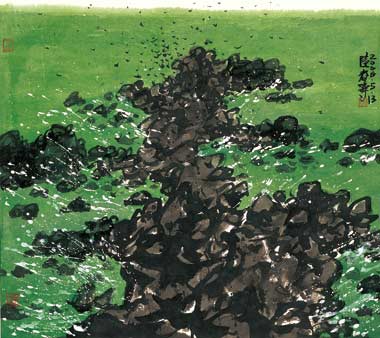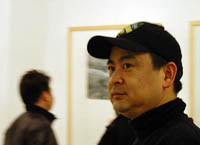 |
|
Artitst Lu Chuntao's "Riverside" series |
Lu Chuntao has successfully switched from traditional ink-wash painting and bird-and-flower themes to unconventional and startling ink wash about a rougher, more powerful nature.
Switching, while retaining the ink-wash spirit, can be difficult because of the absence of vivid colors, layers and textures in the ancient genre.
Lu, a traditional artist for nearly two decades, "found himself" a few years ago and produced works with a wilder, explosive power. His solo exhibition is underway at Xuhui Art Museum.
"What I paint is not that important. The key is to infuse the flowers and birds with verve and spirit as well as form, sentiment and taste all at the same time," says the Shanghai native from Chongming Island.
Two series, "Desolate Valley" and "Alongside the River," emphasize brushstrokes and feelings over content.
"I want to pursue striking visual effects through my brush," he says. "It's easier said than done in regard to the revolution on rice paper. But that's the inevitable trend if we really want to be different from our predecessors."
|

|
|
Lu Chuntao [File photo] |
Compared with his earlier works, his paintings today reflect a sensibility that has opened to a wider natural world, an environment far broader than a limited private space.
"Perhaps it's time for me to break out the 'small bourgeois cage' that limits my ponderings on life and art," he says lightly.
He uses "a different eye" to see natural surroundings and uses his years of experience in design. He uses abrupt geometric shapes and big blocks of color to separate his subject from its surroundings - a great challenge to the traditional aesthetic taste of Chinese landscape paintings.
"His landscapes are fictitious, almost hard to discern at first sight," observes art critic Xie Hai. "But if the viewer checks the title, he or she will get an unexpected feeling that immediately relates to the scenes."
For example, "Desolate Valley" conveys something hopeless and chaotic through seemingly disordered brush strokes, "Alongside the River" is dark and mysterious.
"My work is more like a short poem narrating a soliloquy from my heart, as if it has discovered a musical rhythm that beats among these still points, lines and planes," he says.
Date: through February 22, 10am-4pm
Venue: Xuhui Art Museum, 1413 Huaihai Rd M., Shanghai
(Shanghai Daily February 26, 2009)